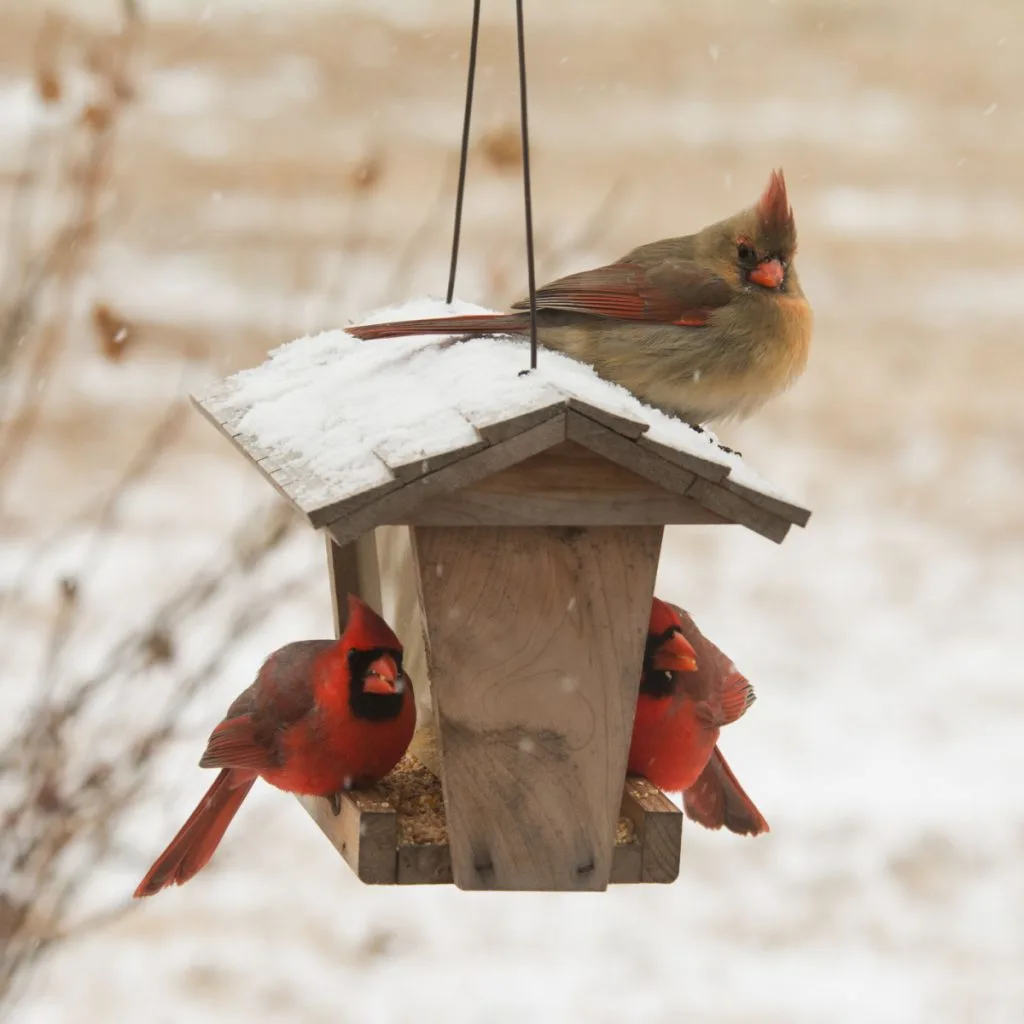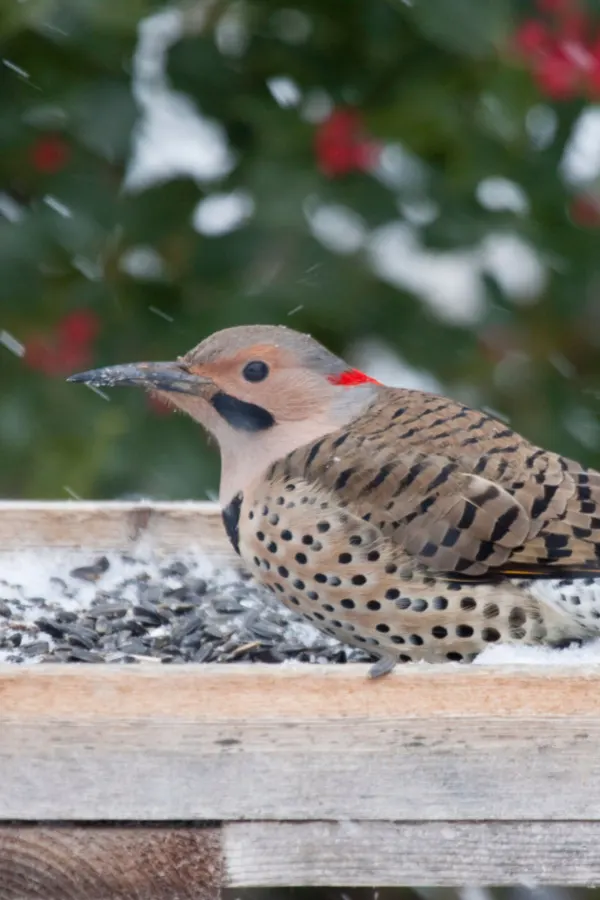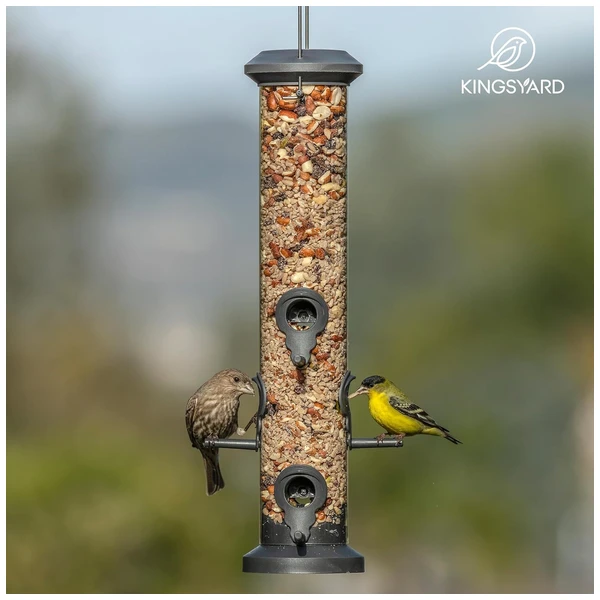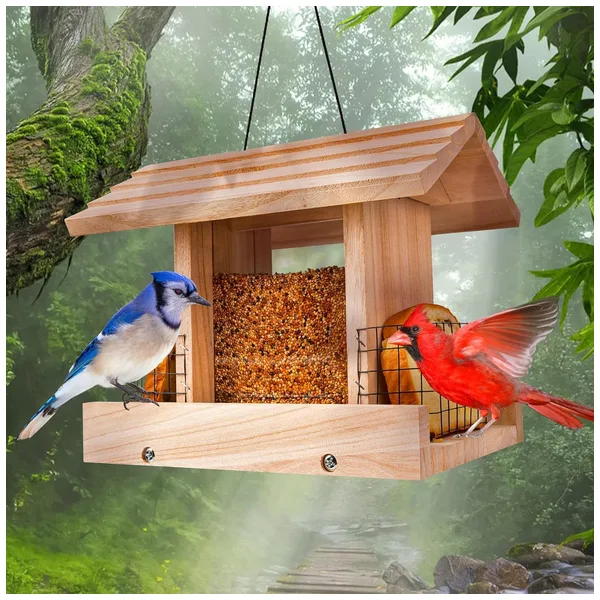Looking for the best type of bird feeders to use for feeding birds all through the long, cold winter months?
There is no more important time to help birds out with a little food in the winter. For cardinals, blue jays, chickadees and other bird species that don’t migrate to warmer locations, food can be scarce during the barren winter months.
Once winter hits full stride, many of the berries, nuts and other food sources birds love are long gone. And even if there happens to still be a bit of food around, it’s often covered under a blanket of snow. Unfortunately, without food, many birds simply don’t make it through til spring.

Unlike squirrels, chipmunks and other small animals that live through harsh winters, birds do not store food reserves away. That, of course, means they need to forage every single day just for survival. Making matters worse, they burn a tremendous amount of calories just trying to stay warm – so they need more food than ever!
This is exactly where helping our feathered friends out with a few well stocked and well placed bird feeders can make all the difference in their survival.
The Best Bird Feeders To Use In Winter
When it comes to feeding birds in the winter, not all bird feeders are the same. There are two important factors that figure in to winter feeding. The first is selecting a feeder that birds can feed easily and quickly from. The second, is to use one that help to keep their food safe from the elements.
In the winter months, feed and seed that is exposed to rain, ice and snow can quickly clump together. Not only can it make it hard for birds to feed, it can also cause the feed to go bad.

Because of this, there are two choices of feeders that stand head and shoulders above others for great winter bird feeding – tube feeders and hopper feeders. Here is a look at each and their advantages, along with a third type of feed and feeder that can help even the hungriest birds satisfy their appetites in a hurry as well!
Tube Feeders – The Best Bird Feeders To Use In Winter
One of the best choices of a feeder for winter feeding is a tube feeder with a protective see-through cover. Especially one that has a lot of perches and feeding holes.
For starters, the clear protective cover does an incredibly good job of protecting the seed. Both from freezing and from getting wet and spoiling. But even more, these long slim feeders with smaller feeding holes do a great job of protecting seeds from large, more aggressive birds – and squirrels too.
By hanging a few tube feeders under a tree or from a clothesline or post, you can provide plenty of food for chickadees, titmice, finches, sparrows and other smaller birds.

These birds often have difficulty finding food when aggressive birds like blue jays drive them away. But with a tube feeder, this problem is never an issue! It’s not to say you shouldn’t feed for blue jays as well, but this allows both to co-exist in peace. See: How To Feed Blue Jays – Without Driving Other Birds Away!
The clear cover is also great because it not only lets the birds see the food, but you as well – making it easy to know when it’s time to head out and fill them up! Affiliate Product Link: Kingsyard 2 Pack Weatherproof Tube Feeders with 6 Feeding Ports
Hopper Feeders – The Best Bird Feeders To Use In Winter
Many birds love to eat with their food in front of them. Cardinals and Chickadees are two great examples of this. In the spring, summer and fall months, tray feeders are great for this.
But in the winter, tray feeders simply don’t provide enough protection for the feed. Rain, snow and sleet can saturate the seed as well as blow it from the tray. Even tray feeders with covers overhead can’t stop the weather from coming in from the side.
But a hopper feeder can – and it can also still allow birds to feed as they do with a tray feeder – with their food in front of them. A good hopper feeder will have a clear protective cover on its side to protect the feed. In addition, it will have a small tray (usually on each side) that birds can front feed from.

Some, like the wooden feeder hopper featured in the photo above also have additional feeding cages for suet, which, as you will see below, is the ultimate food source to feed birds to help them survive winter! Affiliate Link: Wooden Bird Feeder Hopper With Suet Holder
Suet Feeders – The Best Bird Feeders To Use In Winter
In addition to providing birds with great feeders for seeds and nuts, providing them with suet is the ultimate way to give them the energy they need. See our article: How To Make Homemade Bird Suet
Suet is a cake of fat that can contain seeds, nuts and can include small pieces of fruit. For birds, it’s high in calories and fat, which is exactly what they need to help handle the cold! Suet can be purchased in ready to go cakes or can be made at home. Either way, birds love it!
The key with feeding suet to birds in the winter is to secure the cakes to make feeding easy. This is quite easy to do with a suet cage or holder. Suet cages are simple, inexpensive metal or plastic cages that suet sits inside of. Affiliate Product Link: Single Hanging Suet Feeder , Green
Listen In Below To Our Podcast On Winter Bird Feeding!
To use, just place the suet block inside of the cage. Birds can then perch off of the cage and peck away at the high energy food inside. They are extremely easy to use and refill, and for birds, they can be a lifesaver with quick energy.
Here is to feeding the birds in your yard this winter with the best bird feeders around – and to enjoying their songs and insect eating help all spring, summer and fall as well!
Follow Our Facebook Page For Even More Great Tips! Simple Garden Life Facebook Page
Simple Garden Life is a website dedicated to keeping gardening fun, simple and enjoyable! We publish two new articles each week along with a new garden podcast episode every two weeks. This article may contain affiliate links.
